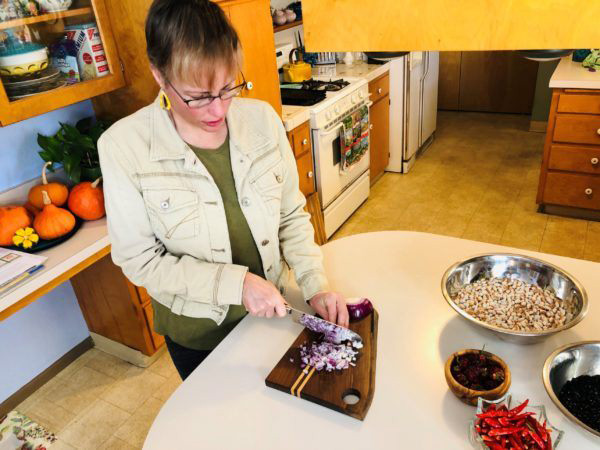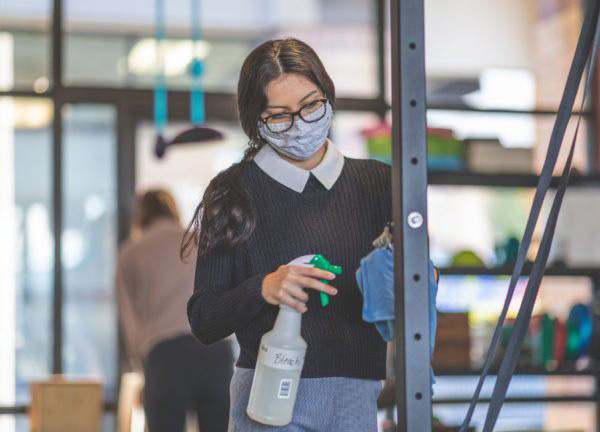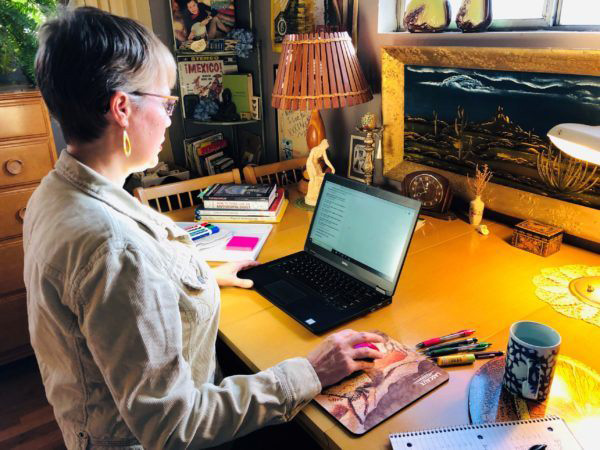#MyPTStory
Professor Nikki Gorrell adapts to online teaching with the help of physical therapy.
When Nikki Gorrell found herself suddenly thrust into the realm of online teaching, she didn’t have a lot of time to prepare. As a professor and the head of the anthropology department at the College of Western Idaho, with additional work at Boise State University, Gorrell typically spent three and sometimes four days a week on campus. Then, COVID-19 turned her world upside down.
As in-person classes were transitioned to virtual learning, Gorrell’s screen time immediately tripled, and without a home office, she had to improvise. Giving more consideration to what her students’ experience would be than to her own well-being and ergonomics, she settled on a space with good lighting and plain wood paneling behind her.

“I really want to be mindful of my background, I don’t want it to be distracting,” she explained, adding that because she records her virtual lessons, she also wants to ensure a professional presentation.
With all the unknowns surrounding the pandemic, like many others, Gorrell put off purchasing a proper desk and ergonomic chair for her home. Instead, she set to work pursuing her teaching passion while settled comfortably on the floor.

Despite the challenges inherent in her new situation, Gorrell persevered through the end of the semester. Summer break brought much needed reprieve from being on screens. The dedicated professor closed her computer and picked up her gardening tools, embracing the break from one passion as a chance to submerge herself in another. The large garden, along with other adventures, kept Gorrell and her partner busy and active during the warm, sunny Idaho months.
But mid-August came quickly, and classes resumed … online. Gorrell picked up right where she left off, teaching back-to-back courses from her makeshift home workstation.
“It was just work, work, work and go, go, go,” Gorrell explained. “Then, within about a month I started noticing this radiating, sometimes shooting, pain emanating from my right shoulder down to my hand.”
Not being one to take over-the-counter pain medication, nor to seek out help, as the weeks went on Gorrell did her best to simply tolerate the pain and discomfort.
“I knew it was getting bad when I was watching myself in my Zoom meetings with my students and I’d be giving myself a massage while I was talking,” she said.
The impulse to continually coax the pain from her shoulder, arm and hand was challenging, but the most difficult thing to contend with was the impact the pain had on her sleep.
“I’m a side sleeper and I could not sleep on either side,” Gorrell said. “In fact, I couldn’t sleep in any position other than flat on my back in corpse pose, and that’s really hard to sleep in.”
When the pain peaked, she was lucky to get two to three hours of sleep a night. The deprivation affected her mood.
“It just makes you feel grumpy. You know, you’re kind of a short fuse.”
Gorrell, an independent spirit who prefers to do things on her own, found herself having to ask for more help than usual. Lifting heavy objects was unbearable. Repetitive motion was especially difficult, which meant processing and chopping the garden harvest brought more pain than joy.
“Then I started to get really nervous when my fingers started tingling,” she said. “That was the final straw, the moment I knew it was getting worse, and then it started to impact how I could use my mouse.”
Heeding the advice of family, Gorrell contacted Therapeutic Associates Physical Therapy and scheduled her first ever PT appointment.

“I guess I had always thought of physical therapy as something for when somebody’s rehabilitating after a major injury,” she explained. “I really didn’t know that physical therapists treat muscular and nerve issues, which is what it turns out I have.”
With continued concerns surrounding the COVID-19 pandemic, visiting a medical clinic for treatment was not something Gorrell approached lightly. However, any nervousness she harbored quickly dissipated when she experienced the safety protocols being followed at TAI.

“I went to the State Street clinic and was very impressed with everything they were doing,” she said. “I appreciated that they wouldn’t even let you in the building without doing a screener, like asking if you are experiencing any symptoms and making sure you were wearing a mask. Inside, there were sanitizing stations everywhere.”
To put her even further at ease, Gorrell said, physical therapist Collin Reid was extremely diligent in asking her questions about her comfort level regarding things like being in a large open room versus a small treatment room, and explaining everything he needed to do before doing it.
“He understood what I needed to feel comfortable — to understand the process, what was going to happen next and what I should expect to feel … and especially during COVID, knowing when he was going to need to get really close and where he needed to place his hands … I appreciated that.”
Diagnosed with a pinched nerve in her middle scalene, Gorrell began her physical therapy journey.
“I was in a lot of pain for about a month, and when you’ve been in that much pain for so long, you really don’t want anybody to touch you – let alone press and push and hold,” Gorrell said. “Collin is so good at talking you through it, and we tried all kinds of different treatments.”
Some of the treatment involved specialty tools, which could be grueling, Gorrell confessed. But, she added, their use contributed to pushing her through to a place where she feels exponentially better and were therefore worth the bouts of discomfort.
As she continued working toward pain-free days, Gorrell decided to try something — she resolved not to open her computer at all during the College’s week-long Thanksgiving break. It worked — the pain subsided in a snap.
“So, then I was like, ‘Okay, now I know what this is about,’” Gorrell said. “It’s tricky though, because at the end of the day it’s not like I’m an athlete and just shouldn’t do that sport anymore … it’s my job. So, then it’s about just trying to work within those bounds, to pace yourself for the long haul.”
“There’s no doubt I’m better than I was a couple of months ago, and it was absolutely physical therapy that got me here,” she emphasized. “But because my working situation hasn’t changed yet … I’m sure by the time I’m done grading for this semester, I’ll be ready for another appointment.”
Where she once considered physical therapy something for extreme situations, now Gorrell recognizes its value in self-care.
“The situation we’re all in right now is different in a lot of ways, and we have to be mindful of what’s happening while we’re working from home, of what’s different than pre-pandemic, and how it might be changing our lifestyles,” she said. “Physical therapy wasn’t even on my radar – it was more like, ‘Maybe I need a massage, or I should just put an ice pack on it.’ But sometimes you need more treatment than that.”
As someone who rarely seeks out medical care, not only did Gorrell once lack the understanding that physical therapy could help her, but she was also unaware that she could seek treatment from a physical therapist directly, without a doctor’s prescription or referral.
“The administrative assistance at the State Street location was super helpful. They took the time to explain the billing and insurance system,” she said. “I was so appreciative because I can really get lost in the weeds with that kind of thing. I was relieved when they told me I didn’t have to go to a doctor’s office before I could start physical therapy.”
With the ongoing prevalence of uncertainty surrounding the COVID-19 pandemic, like Gorrell, many people are facing the continued challenge of working from home. The increased demand for hours spent stationed behind a computer screen poses risk of extreme discomfort, nagging pain and even injury, especially without an ergonomically sound space.
Abnormal positions place undue stress on the musculoskeletal system. Physical therapists emphasize the importance of neutral posture, in which the musculoskeletal system is the most efficient, and recommend keeping feet flat on the floor with knees bent at 90 degrees, sitting up straight, keeping eyes level with the screen, and taking regular micro breaks from sustained postures. Sitting too long at the computer without moving around or changing positions can result in repetitive motion disorders, muscle strain and even pinched nerves such as Gorrell suffered.
While even small adjustments can make a world of difference, for Gorrell, knowing that she’ll be teaching from home at least through May, the end of the school year, and the unknown of what August will bring when the fall semester starts, pushed her to pursue a plan to get off the floor.

“I needed to adapt to the situation,” she reflected, noting that her pain and subsequent path to recovery prompted her to finally purchase a proper desk and chair. Now, when she meets her students online, she’s mindful of not only their experience, but her own well-being, too. Having an ergonomically safe workspace promises to improve the quality of her workday and to protect her body.
“But,” Gorrell added, “now I also know that folding in more physical therapy is going to help me get to a place where I’m stable.”
Learn more about setting up your ergonomic workstation.
Keep a reminder pinned up near your workstation and practice these 10 tips to monitor your ergonomic well-being: Workstation Health Printable.
If you have questions about setting up a comfortable, ergonomically safe workspace, if you are struggling to maintain good posture, or are suffering headaches or nagging neck, back, leg or arm and wrist pain, give us a call to schedule an assessment today! Don’t let your discomfort keep you from being happy or from doing your best work.
Direct access means you can see a physical therapist first, and most insurance policies will cover care without a doctor’s prescription or referral. We are happy to verify your benefits for you.
We are here for your family through in-person or telehealth appointments.
Would you prefer to chat with someone on the phone? No problem! Contact your preferred location today.
